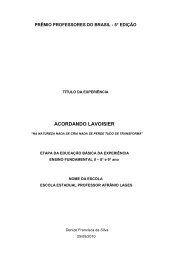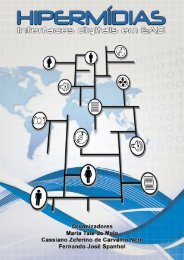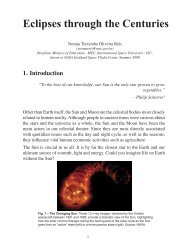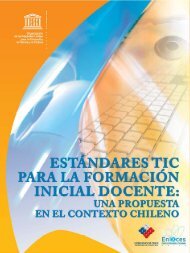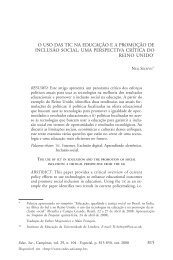BIO-CULTURAL COMMUNITY PROTOCOLS - Portal do Professor
BIO-CULTURAL COMMUNITY PROTOCOLS - Portal do Professor
BIO-CULTURAL COMMUNITY PROTOCOLS - Portal do Professor
You also want an ePaper? Increase the reach of your titles
YUMPU automatically turns print PDFs into web optimized ePapers that Google loves.
APPENDIX RAIKA <strong>BIO</strong>-<strong>CULTURAL</strong> PROTOCOL<br />
Traditional knowledge:<br />
Our traditional knowledge relating to breeds and breeding<br />
has arisen from centuries of experience of tending these<br />
particular breeds in Rajasthan. We have traditional customs<br />
that ensure the genetic diversity of our breeds, such as the<br />
rotation of bulls between villages for stud. We have also<br />
developed extensive local treatment systems (ethnoveterinary<br />
knowledge) with which to care for wounded or<br />
ill animals, and much of this traditional knowledge is<br />
held by both the men and women of our community.<br />
We share our ethno-veterinary knowledge freely with<br />
other communities that own livestock and are perhaps the<br />
only veterinary care for livestock in remote areas of<br />
rural Rajasthan.<br />
WE CONSERVE AND SUSTAINABLE USE<br />
RAJASTHAN’S <strong>BIO</strong>DIVERSITY<br />
We are integral to Rajasthan’s forests, gauchar and oran.<br />
Our animals have contributed to the ecology of the region<br />
to such an extent that they cannot be separated from the<br />
“natural” state of the forests, gauchar and oran.<br />
As our animals graze, they provide manure to otherwise<br />
infertile ground. At the same time, the seeds in the manure<br />
have a higher chance of germination, provide gestation and<br />
increase the natural propagation of local trees. Because our<br />
animals consume the foliage on the ground, it helps to<br />
keep termite numbers low. The feeding on ground fall and<br />
tall grass has also lowered the incidence of forest fires.<br />
For generations we, the Raika, have acted as custodians of<br />
the forest. We have always fought forest fires, dealt with<br />
invasive species poisonous for animals (such as Angrezi Babul<br />
i.e. Prosopis juliflora and the Rukadi i.e. Lantana camara)<br />
and reported illegal logging and poaching. Our customary<br />
laws ban practices that degrade the environment, including<br />
the lopping of sacred trees, and heavy punishments are<br />
meted to community members who break the rules.<br />
Our grazing patterns are based on our traditional ecological<br />
knowledge and establish a strict rotation based on the<br />
seasons over a five year period. At the same we stimulate<br />
tree growth by our practice of lopping of selected trees,<br />
Women also take care of the newborn animals, make<br />
decisions about the sale or transfer of our livestock and sell<br />
milk. Our animal products are totally organic, attributes that<br />
are highly desired in some parts of India. The wool of our<br />
animals is used for making carpets, rope and blankets and<br />
they also provide draught.<br />
Spiritual understanding of our breeds:<br />
Our breeds are more than just a livelihood. They form an<br />
integral part of our social fabric and are interwoven with<br />
spiritual meaning. A number of important holy days involve<br />
rituals that involve our animals and underscore the sacred<br />
ties between our livestock, the environment and our<br />
traditional knowledge.<br />
as well as by our camels that eat the twigs and leaves of<br />
the upper branches. Studies on our grazing patterns have<br />
shown stronger tree growth in areas where our livestock<br />
have traditionally grazed.<br />
Our livestock has become integral to the animal diversity in<br />
forest areas. Predators such as leopards and wolves have<br />
traditionally preyed on our livestock and we consider the<br />
resulting loss of livestock as a natural part of our integral<br />
relationship with the ecosystem. Studies in the Kumbhalgarh<br />
Sanctuary have shown how the leopard population in the<br />
region has been sustained by our livestock and the negative<br />
impacts caused by the exclusion of livestock from the<br />
Sanctuary which include increased encroachment by<br />
leopards into villages leading to dangerous conflicts.<br />
We also provide services to the villages near our grazing<br />
lands and migratory routes. We provide manure to farmers,<br />
either by keeping our animals on their land on a temporary<br />
basis, or by selling it to them directly. People from surrounding<br />
villages use the forest for a variety of needs, including<br />
collecting dry wood, fodder, agricultural nutrient inputs,<br />
medicines, thatch and famine foods. Villagers consider us to<br />
be their guardians in the forest, offering guidance and<br />
protection to them in an otherwise dangerous area.<br />
78





